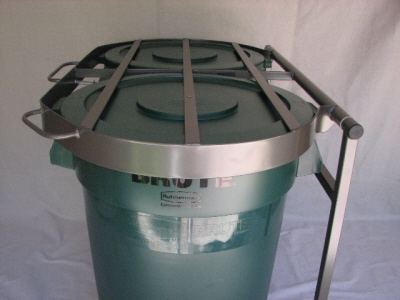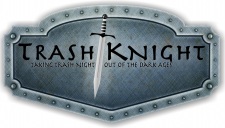Many solid waste companies and municipal landfills have the situation well in hand; do you?
Birds, mammals, and reptiles can be injured or killed by the trash we throw away. The magnitude of the problem is growing every day, especially because some types of litter do not readily disintegrate and therefore remain in the environment as a threat for decades. To help protect wildlife and natural habitats, local cleanup campaigns and recycling plans are now being implemented.
For more information about the Trash Knight system, please visit our website at www.trashknight.com.

The Litter Problem
The amount of litter that ends up spoiling the beauty of the natural environment is not surprising considering the amount of waste we produce. Glass bottles, plastic packaging, tin cans, newspaper, cardboard, and other types of garbage litter urban and rural landscapes everywhere. According to Wildlife Fact File, about 160 million tons of trash is thrown away every year in the U.S. or approximately three and a half pounds per person each day. Paper products alone account for over 40 percent of this garbage. Sometimes the wind blows trash from overloaded garbage cans and litters the environment. Naturally litter can last for a long time depending on the disintegration of the garbage. For example aluminum cans do not disintegrate, and some plastics take decades to break down.
How Litter Threatens Wildlife
Litter can be very harmful to wildlife. Discarded fishing lines can trap the legs, wings, or neck of waterfowl such as swans or moorhens. A fishhook may get stuck in a bird’s throat. Water birds suffer lead poisoning when they accidentally swallow small lead fishing weights. Broken glass can cut the feet of foxes, coyotes, or badgers, and unbroken bottles present a hazard to various small animals. Lizards often crawl inside bottles or cans to bask warm interior, to seek protection or search for food; but they may find it difficult to squeeze out again and can die of overheating. Small mammals in search of food often get their heads caught in the openings of jars. Replacing lids on bottles and jars before discarding can help prevent animals from becoming entrapped. Birds, fish, and mammals may be ensnared by plastic six-pack holders. This can be prevented this by cutting up the plastic rings so that they do not become traps.
Animals That Use Litter
Litter may appear to be helpful to wildlife. At night in some urban areas, foxes look for garbage on the streets. Often they feed on chicken bones, pieces of hamburger, and other leftovers from fast-food meals. During the day pigeons take over from foxes, these birds often flap around a food-laden garbage can of peck crumbs on the pavement. Gulls are well-known scavengers. These birds have greatly increased their number by feeding on thrown-away food. Inland, they gather in flocks over garbage dumps, where they eat even the filthiest scraps.
Human food is not necessarily good for wild animals. Deer, for instance, love bread and sweets. These purified grain products may form gummy masses in the stomachs of ruminants and interfere with digestion. Deer may actually die from ingesting too much food with a flour base. Discarded food can also become contaminated with microorganisms that cause food poisoning. More likely, however, the wild animals will become accustomed to free handouts and be unprepared to hunt for themselves if the source of human food is cut off.
How the Waste Industry is Protecting Animals
There was a time when many animals fell victims to discarded trash in municipal dumps. In addition to the waste itself, wildlife was threatened by heavy equipment workers who did not understand how their actions could threaten a fragile ecosystem. Animals were often struck by trucks or crushed by heavy machinery. Some became entrapped in trenches, open pits or pipes. While dumps still exist in some remote locations, most are being replaced by sanitary landfills.
The evolution of sanitary and secure landfills was accompanied by environmental planning that provided protection for wildlife and guaranteed that the land would be reclaimed for future wildlife inhabitants. Some methods of protection seem to be standard procedures at most landfills and many facilities have some pet project designed to provide for the safety and continued survival of some special creature.
Butterfield Station in Phoenix, Arizona serves as a good example of what precautions are normally taken at Waste Management Inc. (WMI) owned and operated landfills. The landfill is securely fenced to exclude many animals. Strict speed limits are enforced to protect animals from being hit. At the close of every day, all refuse is covered with a six inch covering of soil to keep animals from being injured by the debris. All truck beds and other such containers are covered with tarps to keep animals out. Domestic animals are not permitted in the landfill. Any escaped debris is collected from roadways and along the perimeter of the landfill on an on-going basis. Small waste containers are provided with animal proof lids to keep wild animals from getting to the waste. Many Waste Management facilities provide special roll-off containers for small towns and villages to use during community clean-up events.
It is common for landfills to have pet projects to protect individual species that are of particular concern. Kirby Canyon Recycling and Disposal Facility in Morgan Hill, CA with help from the U.S. Fish and Wildlife Services, City of San Jose, researchers from Stanford University and consulting biologists have embarked upon a conservation plan to increase and maintain the population of the endangered Bay Checkerspot Butterfly. Approximately two hundred and fifty acres have been set aside for the checkerspot, which was nearing extinction in 1985. The Kirby Canyon Conservation Agreement, which celebrated its 10th anniversary in 1996, provides for: the setting aside of land; establishment of a trust fund for studies of the butterfly; management of cattle grazing to ensure appropriate balance of plant resources; habitat restoration and enhancement; and ongoing scientific monitoring of the Bay Checkerspot population. In addition, Kirby Canyon has set aside marshland for the preservation of the endangered Red Legged Frog.
Altamont Landfill and Resource Recovery Facility in Livermore, CA has implemented a special program to protect the endangered San Joaquin Kit Fox. The protection program includes many projects to protect the San Joaquin Kit Fox. Exclusion zones are placed around dens. Limited disturbance of areas adjacent to construction and storage areas must be maintained. Escape ramps are constructed in all holes or trenches greater than 2 feet deep, and sides must have a slope no greater than 45 degrees. Pipes with a diameter of four inches or greater must be inspected for kit foxes before being buried, capped or moved. Vehicles observe a 20 M.P.H. speed limit except on county, state or federal roads. Staff and visitors are instructed not to harass any Kit Fox or other unidentified fox in the vicinity of the landfill. Feeding of wildlife is not permitted. Off road traffic is prohibited. General precautions that are followed at all landfills are observed at Altamont.
The Kettleman Hills Facility in Kettleman City, CA also has protection programs for the San Joaquin Kit Fox, Giant Kangaroo Rat, the Blunt Nosed Leopard Lizard, the San Joaquin Antelope Squirrel, and two state species of concern, the Burrowing Owls and badgers.
Landfills have made great strides in protecting wildlife. But everybody must become involved in protecting wildlife from household waste. Recycling reduces the litter problem. Improvements in package construction can reduce unnecessary waste and make them less harmful to wildlife. Proper disposal methods can help to keep litter that we accumulate from becoming a death trap to wild animals. If people learn to respect the environment and are aware of the threat trash poses to wildlife, they will be less likely to litter.
What You Can Do!
There are many things that your clubs, science classes and families can do to help protect animals from being injured by trash. Below are some ideas.
- Look at the products your family uses. Is there a lot of extra packaging that is not needed? Tell the company by letter, phone or e-mail. They have offices set up to handle such concerns. Don’t buy from companies who refuse to reduce unnecessary packaging.
- Check the trash that your family discards. Does your trash get placed in an animal proof container? That will help protect animals. It is still wise to check each item that you discard. What packages could injure animals? Cut up or tie plastic bags and six pack holders into knots to prevent injury to small animals. Remove can tops completely. Seal food in leak proof bags. Put lids on bottles and jars, or plug holes before disposing of them.
- Get involved with community cleanup projects such as Earth Day
- Better yet, make community clean up a routine. If you see trash in a field or along a road, pick it up (wear gloves or some other hand protection).
- Teach others about the need for protecting animals from trash.











